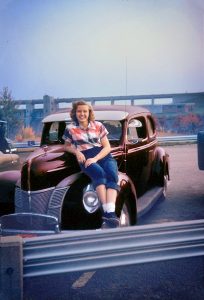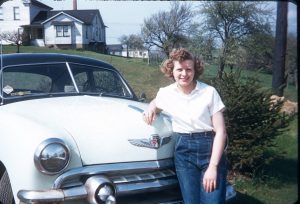After graduating from high school in May of 1951, and before attending Kent State University, I obtained a job at Keller Mines in Deerfield, Ohio (see previous post). Since Deerfield is 15 miles from my home in Randolph I needed a vehicle that I could drive to work. Uncle Leon May generously loaned me his pickup for several weeks until I had enough money to buy a car of my own.
I asked Lamar Jenior, the local Ford dealer, if he had an inexpensive car available. The next day he showed up in our driveway with a 1940 Ford sedan and offered it to me for $250. It appeared to be in good shape for an 11 year old pre-war car, so I bought it. It wasn’t much to look at and needed some tender loving care. The body was solid – no dents or rust, but it needed a paint job in order to come up to the standards of this teenage hotshot. Not only would it be driven to work, but it had to be attractive enough to be used for courting members of the opposite sex.
Fords were the fastest cars available at this time. They were driven by the Ohio State Patrol. The moonshiners also used them to run booze because they handled well and could be easily souped up to outrun the revenuers.
The most common engine in these cars was an 85 horsepower flat-head V-8. They had a hump-back shape and transverse springs just like the old Model-T’s and horse-drawn buggies. This was only the second year that a color other than black was available. Henry Ford did not believe in changing things as long as his cars were selling. “If it ain’t broke don’t fix it” was his motto. 1940 was the first year Henry put hydraulic brakes on his cars. When criticized for this it was rumored that he said, “I make cars to GO, not to stop”. Fords did not change much until 1949, two years after the old tyrant’s death. 1940 was also the first year Henry allowed his cars to have the gear-shift lever on the steering column (more on this later).
My first concern was the color, which was a faded greenish-grey. I found a paint that I liked, “Empire Maroon Metallic”, which was a patented Oldsmobile color. I bought a quart of this paint and a spray gun, and proceeded to decorate my new car. I didn’t have a garage so I had to do the job in our driveway. Unfortunately, my brother had a pet crow that was fascinated by my painting, and showed his interest by repeatedly making bird tracks all over my newly painted roof. I finally became frustrated with his antics and gave him a burst of “Empire Maroon Metallic”. My brother was now the only kid in Randolph who had a maroon crow!
I now concentrated on further customizing. Kenny, my idea man, worked at the West End Garage as a mechanic. He had many ideas on how to further enhance this automobile. It had been driven many miles and the compression was low, it burned oil, and the exhaust was heavy and dark. Fortunately the engine had metal sleeve inserts in the cylinders. Kenny and I replaced these, the piston rings, and all the bearing inserts. We installed hot spark plugs, headers, dual exhaust pipes, and straight mufflers. I now had an engine that operated better than new and sounded really cool!
In the exhaust manifold were two holes that allowed hot exhaust gasses to heat up the carburetor. Kenny told me if we blocked these holes the car would run better and sound even cooler. These holes were the exact size of pennies, so we press-fitted coins into them. Now when I let up on the accelerator a series of popping sounds resulted. I don’t know how this affected the gas mileage, but that didn’t matter since the price of gasoline was 19 cents per gallon.
There was one more very important improvement that needed to be made.
It was the height of coolness for every young stud to drive around town, steering with his left hand, his right arm around a girl. This posed a problem since the gear-shift lever was on the right-hand side of the steering column, and needed to be operated by the arm that was hopefully otherwise occupied. Kenny showed me how to solve this problem. We got underneath the car, unhooked the linkage to the gear-shift lever, flopped it from the right side to the left side of the steering column, and re-attached the linkage. Now shifting could be done with the left hand without losing your grip on the girl! The only problem was that the gear positions were reversed and had to be re-learned. For example, low gear was normally down and toward the driver, now it was up and away from the driver. It was fun to ask a gas station attendant to pull the car up to the pumps (he couldn’t do it!). Of course there was an added advantage. It was very difficult for a thief to steal the car.
This ’40 Ford served me well for 3 years, at which time I up-graded to a 1951 Ford, a more modern car that was built without the limitations imposed by Uncle Henry. It also had an automatic transmission which solved the shifting problem.

1940 Ford – my first car. This picture was taken in 1952. The girl is Elaine Horning, whom I married 5 years later. She was the mother of my 5 children.

1951 Ford – Same girl, different car. This picture was taken just before I was drafted into the U.S. Army